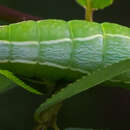Conservation Status
provided by University of Alberta Museums
No concerns. Alberta is at the extreme eastern edge of its range in Canada.
- license
- cc-by-nc
- copyright
- University of Alberta Museums
Cyclicity
provided by University of Alberta Museums
Adults are on the wing in July.
- license
- cc-by-nc
- copyright
- University of Alberta Museums
Distribution
provided by University of Alberta Museums
Quebec west to eastern Alberta, south to Florida and Texas. One Alberta record, from the aspen parklands zone near Wainwright.
- license
- cc-by-nc
- copyright
- University of Alberta Museums
General Description
provided by University of Alberta Museums
A medium-size (2.5-4.0 cm. wingspan) white moth with the forewing etched with fine black zig-zag lines. The orbicular is large and ringed with black, and the reniform is a small black-ringed oval. There is some faint, dark olive or grey shading across the forewing, mainly in the antemedian and subterminal areas. The hindwing is white with some dark scaling on the veins and along the outer margin. The antennae is bipectinate on basal 2/3 and simple for the remainder. They are similar to the closely related Kitten Moths (Furcula sp.), except the Furcula sp. have a broad dark median band on the forewing. The exception, the Grey Kitten, lacks the fine black cross lines of the Black-etched Prominent. Canadian specimens are darker than those from further south, and have been named subspecies multiscripta.
- license
- cc-by-nc
- copyright
- University of Alberta Museums
Habitat
provided by University of Alberta Museums
Deciduous woodland.
- license
- cc-by-nc
- copyright
- University of Alberta Museums
Trophic Strategy
provided by University of Alberta Museums
No Alberta data. Elsewhere reported to use Poplars (Populus), cherry (Prunus) and willows (Salix).
- license
- cc-by-nc
- copyright
- University of Alberta Museums
Americerura scitiscripta: Brief Summary
provided by wikipedia EN
Americerura scitiscripta, the black-etched prominent, is a moth of the family Notodontidae. It is found from Quebec west to eastern Alberta, south to Florida and Texas. The species was formerly placed the genus Tecmessa, and the genus Cerura, which is now restricted to the Old World.
The wingspan is 25–40 mm. Adults are on wing from March to October depending on the location. There are one or two generations per year depending on the location.
The larvae feed on the leaves of cherry, poplar and willow.

Caterpillar
- license
- cc-by-sa-3.0
- copyright
- Wikipedia authors and editors


 Caterpillar
Caterpillar